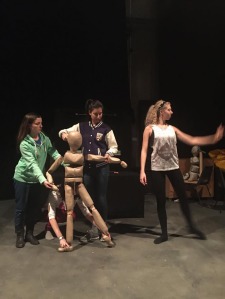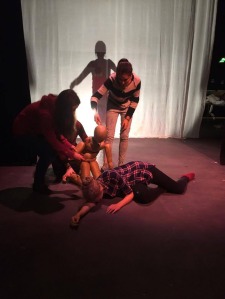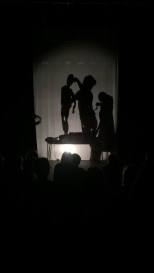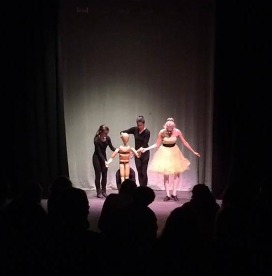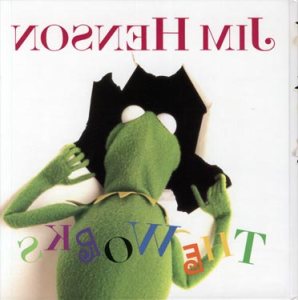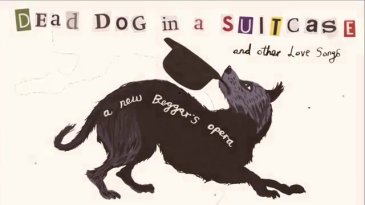
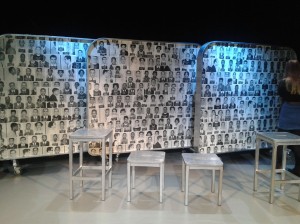
As part of our course, we were given the opportunity to see two individual plays: “Dead Dog in a Suitcase” directed by Mike Shepherd and produced by “KneeHigh”, a UK based theatre company, “Rise Up” directed by Natalie Wilson and produced by Theatre Centre.
To prepare us for writing our final essay for the end of term, we were given the task to write a 400 word essay which would compare the two plays and provide an in-depth analysis of them.
To help provide a clear structure for the essay, we were told to answer four questions about the performances (the text below is a copy of the essay I wrote and submitted).
1. Why tell the story?
Both plays can be considered warnings. One from the past and the other from an apocalyptic present/future.
‘Rise Up’ is a documentary play about ethnic segregation in 1960’s America. This play shows glimpses of hope for the future, but also indicates that this story needs to continue to be told so that we don’t forget to apply its message to the present day – that all men and women are equal.
“Dead Dog in a Suitcase” is an adaptation of “The Beggars Opera” (1798), set in the present day, or an apocalyptic future and centres on a criminal named Macheath. The writer, Carl Grose chose to use this play to get across his anger about the current state of mankind. Congruent to ‘Rise Up’, ‘Dead Dog’ shows the consequences of not learning and continuing old ways of thinking, – quote from ‘Dead Dog’, “That’s the problem, it’s just like the old days”.
In ‘Dead Dog’ the story ties in to the story of ‘Punch and Judy’, by having the main character behave similarly to Mr Punch.
Punch and Judy performances produce shocked laughter but hide very dark themes. ‘Dead Dog’ is a similar case; the character of Mr Punch the puppet, is even featured within the story as Macheath’s inner voice.
‘Dead Dog’ also focuses on politics, another reference to today’s society, and the hunger for love and justice. The characters in the play can be compared to puppets who are without a master, no authority figure, no rules and no leader. This play, in my eyes, is the writer’s way of warning us of the consequences of living by our own individual rules. By the end of the play, even the more confident and arrogant of the characters become vulnerable, lost and confused as they slowly drown in their own evil ways.
The director of ‘Rise Up’ informed us after the play that she ultimately wanted to make the audience feel like “global citizens”, and that we all need to come together as one, an idea that goes against todays post-modern society, which is self-serving, individualistic, goal focused, combined with the loss of unity; all things displayed in ‘Dead Dog’.
2. How is the story told?
‘Rise Up’ was presented by four British actors, who had the heavy task of playing 40 characters in the play. By having British actors play the roles of American people it helped to bring the story closer to home. There were three black actors and one white actor. At times a black actor could play the role of a white man and the white actor the role of a black man. The female actors could also play male roles and vice versa. This emphasised the plays theme that we are all equal and presented a political element to the story to get across to younger audiences and challenge their way of thinking. ‘Dead Dog’ was told as a musical, including songs which directly asked the audience, ”What the heck is going on?” within the play. This is where I think ‘Rise Up’ fell flat! At no point did any of the characters in the play get the audience to question what was going on behind the story – why segregation and prejudice existed. Instead, it focused solely on retelling key events and relaying facts, which later made people in the audience question why this story was being directed at us fifty years on.
3. How did the design help to tell the story?
Unlike ‘Rise Up’, which was performed on a small scale with a floor mat and backdrop, ‘Dead Dog’ was performed on a large theatre stage with a much louder and aggressive tone corresponding with the theme. The play also featured slower moments of contemplation with certain characters singing sad songs about how they desire a better life and in contrast there are moments which directly follow these songs which show other characters being perverse and singing slightly more comedic songs. This could be the writer’s way of showing that his message is falling upon death ears. The set for ‘Dead Dog’ needed to be larger than ‘Rise Up’, in order to reach out to a larger number of people and represent the full extent of the writer’s anger through the design of the set.
‘Rise Up’s play only had 4 actors and only required a small set in order to create a more intimate environment which fitted to the story which is very personal to some people and conveys a more serious tone. The only props to be used in ‘Rise Up’ were 4 stools of different heights to create different levels in the play, making the design more dynamic. When performing in front of an audience, particularly schools (which ‘Rise Up’ would be performing to on their tour), as a designer, you need to include different levels within your set to keep the audience engaged i.e. stools, chairs, platforms etc. ‘Dead Dog’ also understood this by having their set resemble a playground, within a backstreet urban environment, allowing actors to climb scaffolding, slid down an actual slide, climb stairs, stand on rotating platforms and hang from ropes.
The set for ‘Rise Up’ was simple, 3 movable backdrops covered in aluminium (linking to the buses of the 1960’s where black and white people were separated) and a floor mat – which adds a frame to the design. This didn’t provide the characters with much to work with. However, this didn’t matter considerably, because with 4 actors to play 40 characters, the focus relies more on their performances as opposed to their environment.
4. What was challenging?
Both sets for ‘Rise Up’ and ‘Dead Dog’ are stationary, with the exception of a separate moving platform featured in ‘Dead Dog’. This means that both plays have the task of transporting the audience to different locations whilst remaining in one set. I noticed that to achieve this, both plays used different lighting schemes to represent different or similar locations. This meant that the audience subconsciously recognised certain environments whenever a specific lighting scheme was used. For example, a telephone call in ‘Rise Up’ would be represented with a spotlight effect, a cold harbour in ‘Dead Dog’ would have a dark blue lighting scheme and inside a building would have bright harsh lighting.

